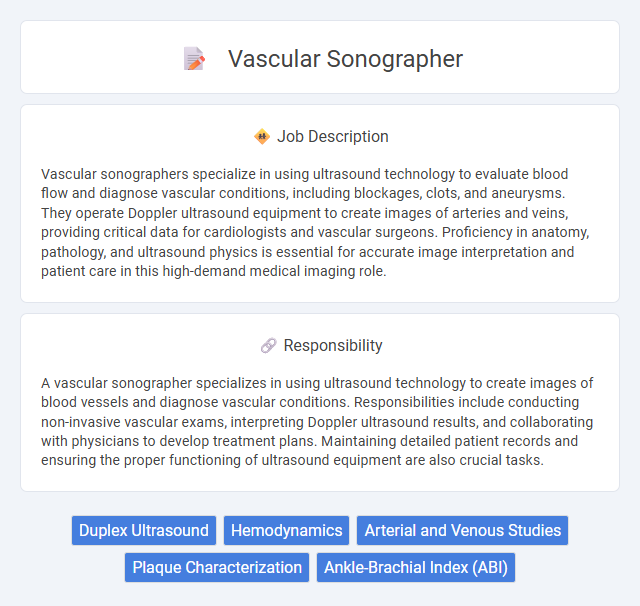
Vascular sonographers specialize in using ultrasound technology to evaluate blood flow and diagnose vascular conditions, including blockages, clots, and aneurysms. They operate Doppler ultrasound equipment to create images of arteries and veins, providing critical data for cardiologists and vascular surgeons. Proficiency in anatomy, pathology, and ultrasound physics is essential for accurate image interpretation and patient care in this high-demand medical imaging role.
Individuals with strong attention to detail and good interpersonal skills may likely excel as vascular sonographers, given the need to accurately capture and interpret vascular images. Those comfortable working with medical technology and patient interactions are probably well-suited for this role. However, people with a preference for minimal patient contact or low tolerance for standing long hours might find this job less compatible with their preferences.
Qualification
A vascular sonographer must possess specialized training in diagnostic medical sonography, typically requiring an associate or bachelor's degree in sonography or a related field. Certification through organizations such as the American Registry for Diagnostic Medical Sonography (ARDMS) with a vascular specialty credential (RVT) is highly preferred. Strong knowledge of anatomy, physiology, and proficiency in operating ultrasound equipment are essential qualifications for accurate vascular imaging and diagnosis.
Responsibility
A vascular sonographer specializes in using ultrasound technology to create images of blood vessels and diagnose vascular conditions. Responsibilities include conducting non-invasive vascular exams, interpreting Doppler ultrasound results, and collaborating with physicians to develop treatment plans. Maintaining detailed patient records and ensuring the proper functioning of ultrasound equipment are also crucial tasks.
Benefit
Vascular sonographers likely experience job benefits such as competitive salaries and comprehensive healthcare packages due to the specialized nature of their skills. Opportunities for professional growth and certifications may enhance career advancement and earning potential. Work schedules might be flexible in some settings, contributing to a better work-life balance.
Challenge
Vascular sonographer roles likely involve complex diagnostic challenges due to the intricate nature of vascular systems and the need for precise imaging techniques. The probability of encountering difficult cases may increase as patients present with varying degrees of vascular disease, requiring adaptable technical skills and critical thinking. Continuous advancements in ultrasound technology might further demand ongoing learning and skill enhancement to meet diagnostic accuracy standards.
Career Advancement
Vascular sonographers have strong career advancement opportunities through specialized certifications such as Registered Vascular Technologist (RVT) or Certified Vascular Sonographer (CVS). Experience in diagnostic imaging and proficiency with Doppler ultrasound technology can lead to senior roles or supervisory positions in medical imaging departments. Pursuing continuing education and skills in related fields like cardiovascular sonography can enhance employability and open paths toward healthcare management or education roles.
Key Terms
Duplex Ultrasound
Vascular sonographers specialize in performing Duplex Ultrasound to visualize blood flow and assess vascular conditions such as arterial blockages, aneurysms, and deep vein thrombosis. Utilizing high-frequency sound waves, they generate real-time images and Doppler studies that provide critical information about vessel patency and blood velocity. Expertise in interpreting Duplex Ultrasound results is essential for diagnosing peripheral vascular diseases and guiding treatment plans.
Hemodynamics
A vascular sonographer specializes in using ultrasound technology to evaluate blood flow and diagnose circulatory system disorders by assessing hemodynamics in arteries and veins. This role involves capturing detailed images and Doppler signals to measure blood velocity, pressure, and vessel wall integrity, providing critical data for detecting conditions such as thrombosis, stenosis, and aneurysms. Advanced knowledge of hemodynamic principles and ultrasound physics is essential for accurate interpretation and aiding vascular surgeons in treatment planning.
Arterial and Venous Studies
Vascular sonographers specialize in conducting arterial and venous studies to evaluate blood flow and detect abnormalities such as blockages, clots, or vascular diseases. Using advanced ultrasound technology, they produce detailed images that assist physicians in diagnosing conditions like deep vein thrombosis, peripheral artery disease, and carotid artery stenosis. Expertise in Doppler ultrasound techniques ensures accurate assessment of blood velocity and vessel health for optimal patient care.
Plaque Characterization
Vascular sonographers specialize in plaque characterization by using high-resolution ultrasound imaging to detect and evaluate the composition, size, and stability of arterial plaques. Accurate plaque characterization is critical for assessing the risk of cardiovascular events like stroke or myocardial infarction. Advanced techniques such as Doppler ultrasound and ultrasound elastography enhance the detection of vulnerable plaques, aiding in timely clinical intervention and patient management.
Ankle-Brachial Index (ABI)
A vascular sonographer specializes in imaging vascular structures, performing tests such as the Ankle-Brachial Index (ABI) to assess peripheral artery disease by comparing blood pressure in the ankle and arm. Accurate ABI measurements help detect arterial blockages and guide treatment plans for patients with circulatory issues. Expertise in Doppler ultrasound techniques and interpretation of ABI results is critical for vascular sonographers to ensure diagnostic precision and optimal patient outcomes.
 kuljobs.com
kuljobs.com